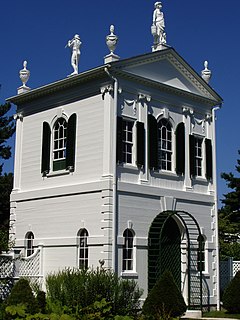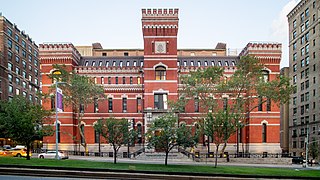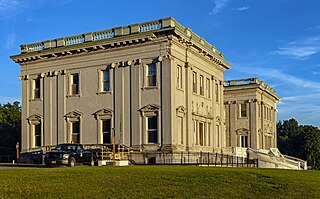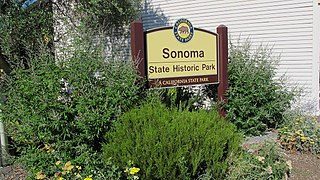
Malakoff Diggins State Historic Park is a state park unit preserving the largest hydraulic mining site in California, United States. The mine was one of several hydraulic mining sites at the center of the 1882 landmark case Woodruff v. North Bloomfield Mining and Gravel Company. The mine pit and several Gold Rush-era buildings are listed on the National Register of Historic Places as the Malakoff Diggins-North Bloomfield Historic District. The "canyon" is 7,000 feet (2,100 m) long, as much as 3,000 feet (910 m) wide, and nearly 600 feet (180 m) deep in places. Visitors can see huge cliffs carved by mighty streams of water, results of the mining technique of washing away entire mountains of gravel to wash out the gold. The park is a 26-mile (42 km) drive north-east of Nevada City, California, in the Gold Rush country. The 3,143-acre (1,272 ha) park was established in 1965.

Marble House, a Gilded Age mansion located at 596 Bellevue Avenue in Newport, Rhode Island, was built from 1888 to 1892 as a summer cottage for Alva and William Kissam Vanderbilt and was designed by Richard Morris Hunt in the Beaux Arts style. It was unparalleled in opulence for an American house when it was completed in 1892. Its temple-front portico resembles that of the White House.

The Pardee Home is a house in Oakland, California. It was the home of three generations of the Pardee family. It is now a non-profit museum showing over 100 years of the life of a prominent California family. The house, a well-preserved example of Italianate architecture, is a city landmark, a California Historical Landmark, and listed on the National Register of Historic Places.

The Derby Summer House, also known as the McIntire Tea-house, is a summer house designed in 1793 by architect Samuel McIntire, now located on the grounds of the Glen Magna Farms, Danvers, Massachusetts. Since 1958 it has been owned by the Danvers Historical Society. A National Historic Landmark, it is significant as an extremely rare and well-preserved example of an 18th-century summer house, and also includes some of the earliest American sculpture in the carved wooden figures mounted on its roof.

The Morris–Butler House is a Second Empire-style house built about 1864 in the Old Northside Historic District of Indianapolis, Indiana. Restored as a museum home by Indiana Landmarks between 1964 and 1969, the American Civil War-era residence was the non-profit organization's first preservation project. Restoration work retained some of its original architectural features, and the home was furnished in Victorian and Post-Victorian styles. Its use was changed to a venue for Indiana Landmarks programs, special events, and private rentals following a refurbishment in 2013. Regular daily tours of the property have been discontinued.

The Seventh Regiment Armory, also known as Park Avenue Armory, is a historic National Guard armory building located at 643 Park Avenue in the Upper East Side neighborhood of Manhattan, New York City. The building is a brick and stone structure built in 1880 and designed in the Gothic Revival style by Charles Clinton.

The Staatsburgh State Historic Site preserves a Beaux-Arts mansion designed by McKim, Mead, and White and the home's surrounding landscape in the hamlet of Staatsburg, Dutchess County, New York, United States. The historic site is located within Ogden Mills & Ruth Livingston Mills State Park. The mansion, a New York State Historic Site, is considered a fine example of the great estates built during the Gilded Age.
Ruth Comfort Mitchell Young was an American author and playwright who wrote under her maiden name Ruth Comfort Mitchell, as well as her married name, Mrs. Sanborn Young. She was the wife of California State Senator Sanborn Young.

William Sanborn Young was a California State Senator, best known for being the husband of author Ruth Comfort Mitchell Young.

The Sarah Orne Jewett House is a historic house museum at 5 Portland Street in South Berwick, Maine, United States. The house was designated a National Historic Landmark in 1991 for its lifelong association with the American author Sarah Orne Jewett (1849–1909), whose influential work exemplified regional writing of the late 19th century. The house, built in 1774, is a high-quality example of late Georgian architecture. It is now owned by Historic New England, and is open for tours every weekend between June and October, and two Saturdays per month the rest of the year.

Sonoma State Historic Park is a California State Park located in the center of Sonoma, California. The park consists of six sites: the Mission San Francisco Solano, the Sonoma Barracks, the Blue Wing Inn, La Casa Grande, Lachryma Montis, and the Toscano Hotel.
On Wong, more commonly known as Ah Louis, was a Chinese American banker, labor contractor, farmer, and shopkeeper in San Luis Obispo, California, during the late 19th and early 20th century. His Ah Louis Store building is on the National Register of Historic Places. Ah Louis was a central figure in the development of the Central Coast of California, serving as an organizer of Chinese laborers during the construction of the Pacific Coast Railway's Avila—Port Harford spur and the tunnels through Cuesta Grade over the Santa Lucia Range.

The Casa de Estudillo, also known as the Estudillo House, is a historic adobe house in San Diego, California, United States. It was constructed in 1827 by José María Estudillo and his son José Antonio Estudillo, early settlers of San Diego and members of the prominent Estudillo family of California, and was considered one of the finest houses in Mexican California. It is located in Old Town San Diego State Historic Park, and is designated as both a National and a California Historical Landmark in its own right.

Wrights, California is a ghost town in unincorporated west Santa Clara County, California. It is located near Summit Road in the Santa Cruz Mountains, on the north bank of Los Gatos Creek, east of State Route 17.

The Willa Cather House, also known as the Willa Cather Childhood Home, is a historic house museum at 241 North Cedar Street in Red Cloud, Nebraska. Built in 1878, it is the house where author Willa Cather (1873–1947) grew up. Cather's descriptions of frontier life in Nebraska were an important part of literary canon of the early 20th century. The house was declared a National Historic Landmark in 1971. The house is one of eight structures that make up the Willa Cather State Historic Site, which is operated by the Willa Cather Foundation.

Angel Island Immigration Station was an immigration station in San Francisco Bay which operated from January 21, 1910 to November 5, 1940, where immigrants entering the United States were detained and interrogated. Angel Island is an island in San Francisco Bay. It is currently a State Park administered by California State Parks and a California Historical Landmark. The island was originally a fishing and hunting site for Coastal Miwok Indians, then it was a haven for Spanish explorer Juan Manuel de Ayala. Later, it was developed as a cattle ranch, then, starting with the Civil War, the island served as a U.S. Army post. During the island's Immigration Station period, the island held hundreds of thousands of immigrants, the majority from China, Japan, India, Mexico and the Philippines. The detention facility was considered ideal because of its isolated location, making it very easy to control immigrants, contain outbreaks of disease, and enforce the new immigration laws. The station is listed on the National Register of Historic Places under the title Angel Island, U.S. Immigration Station, and is a National Historic Landmark. The station is open to the public as a museum – "a place for reflection and discovery of our shared history as a nation of immigrants".

尤方玉屏, Alice Fong Yu was the first Chinese American public school teacher and a community organizer in San Francisco, California. She was a founding member and first president of the Square and Circle Club (方圓社), and was a prominent leader in the San Francisco Chinatown community.

Emily Eolian Williams was a pioneering woman in architecture who was active in Pacific Grove, San Jose and San Francisco in the early 20th century, at a time, when very few women were able to enter the profession. She mainly designed houses, with conveniently planned interiors, and a few institutional buildings and an exhibition stand at the Panama-Pacific International Exposition in San Francisco.

The Julia Morgan Theater, located in the former St. John's Presbyterian Church, is a historic building in Berkeley, California designed by architect Julia Morgan. The wooden building at 2640 College Avenue is built in the American Craftsman style with an exterior wood-shingle finish known as Berkeley Brown Shingle. The church building was desanctified and sold when the congregation moved to a new building in 1974. It now houses the Berkeley Playhouse. The structure is #8 on the city of Berkeley's list of historic landmarks. In 1975 it was added to the National Register of Historic Places.

The Bayview Opera House, formerly known as South San Francisco Opera House, is a theatre at 4705 3rd Street in Bayview-Hunters Point district, San Francisco. Founded in 1888, it is reputed to be the oldest existing theatre in the city. It became a listed City of San Francisco landmark on October 28, 1968, and on March 21, 2011 it was listed on the National Register of Historic Places. From 2014 to 2016, the theatre underwent renovation.





















